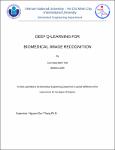| dc.description.abstract | Machine learning is a field that evolved from the subfield of pattern recognition and computational learning theory in artificial intelligence. It focuses on constructing algorithms that can learn and make predictions on data. They operate by building a model from existing training inputs in order to make suitable decisions.
There are three major breakthroughs in machine learning recently. The first breakthrough is the conception of GPU-accelerated learning that boosted the computational power immensely. The second breakthrough is the introduction of an efficient Convolutional Neural network architecture which ended a small period of decline in machine learning research. The third breakthrough is the successful development of Deep Reinforcement Learning (or Deep Q-Learning) which appeared in the famous AlphaGo AI.
In this work, we studied an implementation of Deep Q-learning in a medical problem: localizing brain tumors in Magnetic Resonance Images.
Keywords: Convolutional Neural Network (CNN), Deep Reinforcement Learning (DRL), Deep Q-learning, Magnetic Resonance Imaging (MRI), object localization. | en_US |


